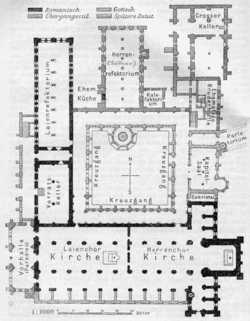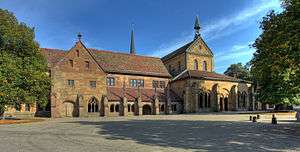Maulbronn Monastery
| Imperial Monastery of Maulbronn | ||||||||||
| Reichskloster Maulbronn | ||||||||||
| Imperial Abbey of the Holy Roman Empire | ||||||||||
| ||||||||||
 Layout of the Maulbronn Monastery | ||||||||||
| Capital | Maulbronn Abbey | |||||||||
| Government | Theocracy | |||||||||
| Historical era | Middle Ages | |||||||||
| • | Founded as Imperial abbey | 1147 | ||||||||
| • | Placed under Imperial protection by Barbarossa |
1156 | ||||||||
| • | Seized by Württemberg | 1504 | ||||||||
| • | Monastery alternates between Protestantism and Cistercians |
1534–1651 | ||||||||
| • | Peace of Westphalia settles monastery to Protestantism |
1648 | ||||||||
| • | Secularised to Württemberg | 1806 | ||||||||
| • | Seminary merged with that of Bebenhausen |
1818 | ||||||||
| ||||||||||
| Today part of | | |||||||||
Maulbronn Monastery (German: Kloster Maulbronn) is a former Roman Catholic Cistercian Abbey and Protestant seminary located at Maulbronn in the German state of Baden-Württemberg.[1] The 850 year old, mostly Romanesque monastery complex, one of the best preserved examples of its kind in Europe,[2] is one of the very first buildings in Germany to use the Gothic style.[3] In 1993, the abbey was declared a UNESCO World Heritage Site.[4]
The complex, surrounded by turreted walls and a tower gate, today houses the Maulbronn town hall and other administrative offices, a police station, and several restaurants. The monastery itself contains an Evangelical seminary in the Württemberg tradition.
History
Founding
The monastery was founded in 1147 by 12 Cistercian monks from Alsace[1] under the auspices of the first Cistercian pope, Eugenius III. The main church, built in a style transitional from Romanesque to Gothic, was consecrated in 1178 by Arnold, Bishop of Speyer. A number of other buildings — infirmary, refectory, cellar, auditorium, porch, south cloister, hall, another refectory, forge, inn, cooperage, mill, and chapel — followed in the course of the 13th century. The west, east and north cloisters date back to the 14th century, as do most fortifications and the fountain house or lavatorium.
After the Reformation broke out in the year 1517, Ulrich, Duke of Württemberg, seized the monastery in 1504, later building his hunting lodge and stables there. The monastery was pillaged repeatedly: first by the knights under Franz von Sickingen in 1519, then again during the German Peasants' War six years later. In 1534, Duke Ulrich secularised the monastery, but the Cistercians regained control — and Imperial recognition — under Charles V's Augsburg Interim. In 1556, Christoph, Duke of Württemberg, built a Protestant seminary, with Valentin Vannius becoming the first abbot two years later, odd, because the Reformation banned religious orders and abbots; Johannes Kepler studied there 1586–89.
In 1630, the abbey was returned to the Cistercians by force of arms, with Christoph Schaller von Sennheim becoming abbot. This restoration was short-lived, however, as Gustavus Adolphus of Sweden forced the monks to leave again two years later, with a Protestant abbot returning in 1633; the seminary reopened the following year, however the Cistercians under Schaller also returned in 1634. Under the Peace of Westphalia, in 1648, the confession of the monastery was settled in favour of Protestantism; with abbot Buchinger withdrawing in process. A Protestant abbacy was re-established in 1651, with the seminary reopening five years later. In 1692, the seminarians were removed to safety when Ezéchiel du Mas, Comte de Mélac, torched the school, which remained closed for a decade.
The monastery was secularised by Frederick I, King of Württemberg, in the course of the German Mediatisation in 1807, forever removing its political quasi-independence; the seminary merged with that of Bebenhausen the following year, now known as the Evangelical Seminaries of Maulbronn and Blaubeuren.
The monastery, which features prominently in Hermann Hesse's novel Beneath the Wheel, was inscribed on the World Heritage List in 1993. The justification for the inscription was as follows: "The Maulbronn complex is the most complete survival of a Cistercian monastic establishment in Europe, in particular because of the survival of its extensive water-management system of reservoirs and channels". Hesse himself attended the monastery before fleeing in 1891 after a suicide attempt, and a failed attempt to save Hesse from his personal religious crisis by a well-known theologian and faith healer.[5]
To represent Baden-Württemberg, an image of the Abbey appears on the obverse of the German 2013 €2 commemorative coin.

References
Bibliography
- Eyewitness Travel Guide to Germany. 95 Madison Avenue, New York, NY: Dorling Kindersley Publishing. August 6, 2001. ISBN 0-7894-6646-5.
Citations
- 1 2 DK Publishing, p. 228
- ↑ DK Publishing, p. 190
- ↑ "Maulbronn Monastery". Staatliche Schlösser und Gärten in Baden-Württemberg. Baden-Württemberg.
- ↑ "Maulbronn Monastery Complex". UNESCO World Heritage. United Nations Educational, Scientific, and Cultural Organization.
- ↑ Hermann Hesse: Background, childhood and youth (1877–95)
External links
![]() Media related to Maulbronn Monastery complex at Wikimedia Commons
Media related to Maulbronn Monastery complex at Wikimedia Commons


